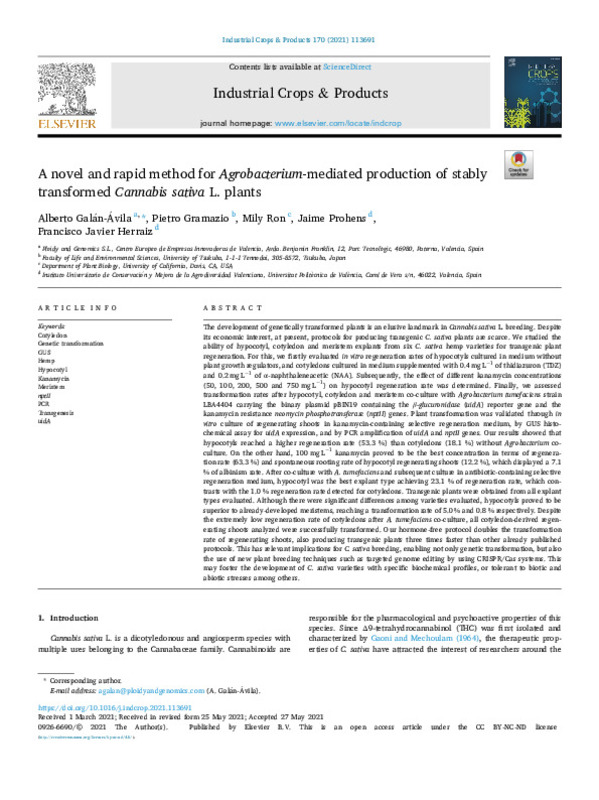|
Resumen:
|
[EN] The development of genetically transformed plants is an elusive landmark in Cannabis sativa L. breeding. Despite
its economic interest, at present, protocols for producing transgenic C. sativa plants are scarce. We ...[+]
[EN] The development of genetically transformed plants is an elusive landmark in Cannabis sativa L. breeding. Despite
its economic interest, at present, protocols for producing transgenic C. sativa plants are scarce. We studied the
ability of hypocotyl, cotyledon and meristem explants from six C. sativa hemp varieties for transgenic plant
regeneration. For this, we firstly evaluated in vitro regeneration rates of hypocotyls cultured in medium without
plant growth regulators, and cotyledons cultured in medium supplemented with 0.4 mg L- 1 of thidiazuron (TDZ)
and 0.2 mg L- 1 of ¿-naphthaleneacetic (NAA). Subsequently, the effect of different kanamycin concentrations
(50, 100, 200, 500 and 750 mg L- 1) on hypocotyl regeneration rate was determined. Finally, we assessed
transformation rates after hypocotyl, cotyledon and meristem co-culture with Agrobacterium tumefaciens strain
LBA4404 carrying the binary plasmid pBIN19 containing the ß-glucuronidase (uidA) reporter gene and the
kanamycin resistance neomycin phosphotransferase (nptII) genes. Plant transformation was validated through in
vitro culture of regenerating shoots in kanamycin-containing selective regeneration medium, by GUS histochemical
assay for uidA expression, and by PCR amplification of uidA and nptII genes. Our results showed that
hypocotyls reached a higher regeneration rate (53.3 %) than cotyledons (18.1 %) without Agrobacterium coculture.
On the other hand, 100 mg L- 1 kanamycin proved to be the best concentration in terms of regeneration
rate (63.3 %) and spontaneous rooting rate of hypocotyl regenerating shoots (12.2 %), which displayed a 7.1
% of albinism rate. After co-culture with A. tumefaciens and subsequent culture in antibiotic-containing selective
regeneration medium, hypocotyl was the best explant type achieving 23.1 % of regeneration rate, which contrasts
with the 1.0 % regeneration rate detected for cotyledons. Transgenic plants were obtained from all explant
types evaluated. Although there were significant differences among varieties evaluated, hypocotyls proved to be
superior to already-developed meristems, reaching a transformation rate of 5.0 % and 0.8 % respectively. Despite
the extremely low regeneration rate of cotyledons after A. tumefaciens co-culture, all cotyledon-derived regenerating
shoots analyzed were successfully transformed. Our hormone-free protocol doubles the transformation
rate of regenerating shoots, also producing transgenic plants three times faster than other already published
protocols. This has relevant implications for C. sativa breeding, enabling not only genetic transformation, but also
the use of new plant breeding techniques such as targeted genome editing by using CRISPR/Cas systems. This
may foster the development of C. sativa varieties with specific biochemical profiles, or tolerant to biotic and
abiotic stresses among others.
[-]
|









